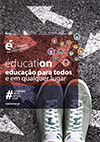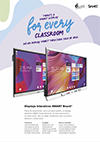Future Classroom Lab: for a teaching full of technology and innovation
They are everywhere because they are the future! Tomorrow's schools anticipated due to a pandemic called COVID-19 that accelerated the digital revolution in education, but there is still a way to go in favor of innovative democratic teaching with a focus on the student and on the development of their skills. Ésistemas' solutions help tread this path by promoting interaction, content sharing and the involvement of students in more dynamic and attractive classes.
A classroom of the future is a reflection of an educational environment that meets the emerging requirements of social and technological evolution. In other words, in practice, the classroom of the future is a technological classroom, which privileges innovative methods of learning through hardware and software, responsible for stimulating students' attention and, consequently, favouring positive academic achievement. The term "Future Classroom Lab” is also closely associated with the expression classroom of the future, but it should be noted that more than transforming the physical space of the classroom into a "laboratory” environment, properly equipped with state-of-the-art technology, it is intended invest on digital pedagogies and encourage motivation and interest in knowledge, creativity, communication, interaction and teamwork, key skills in learning processes. But one thing is true: accepting that technology makes teaching easier is accepting an absolute truth. And it makes it a lot easier!
Discover the key benefits of the Future Classroom Lab
Interaction: between teacher and student, between classmates, for dynamics on the scale of the educational institution or even on a global scale. Interaction is the central point of the school of the future, which intends to be increasingly interconnected and globalized, advocating the sharing of content and the exploration of experiences that promote knowledge.
Virtual Reality: we all know that theoretical classes are not successful among students. Enriching them with authentic immersive trips to the places where everything happened will certainly guarantee maximum attention. Why not approach Classical Antiquity with a short trip to Rome to visit monuments or archaeological remains? The classroom of the future can contemplate enriching immersive experiences that make all the difference in the memory of students for the assimilation of knowledge.
Collaboration and Content Sharing: using technology it is easy to share notes, documents, images, in short, countless contents, promoting interpersonal skills essential for team work.
Autonomy: no less important than stimulating skills for team work is also developing skills in terms of autonomy and leadership. The student must be the protagonist of the learning process and once again technology can help in this aspect through gaming (educational game software).
As can be easily seen, the advantages are added to these technological teaching models that pass through the online universe, but it is necessary to ensure that everyone will have the same access to technology because this is the only way to leverage general progress in education. The pandemic showed us that, although some educational institutions are prepared or have, in the meantime, prepared to implement remote learning during confinement, many of their students did not have the tools at home to monitor what was required of them, from computers to internet, which made it difficult for some to monitor teaching content and for others made it impossible, creating a barrier to access to education that is no longer egalitarian. The Government and some educational institutions have already provided educational spaces and students with the necessary resources, which shows that we are on the right path to implement the classroom of the future in a generalized manner, but time is pressing and schools also play a role determinant in this path towards access to information technologies for all children and young adults.
-
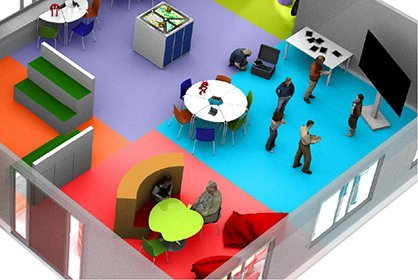 >
> -
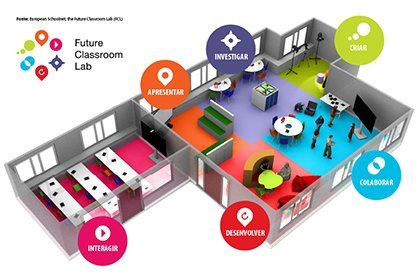 >
> -
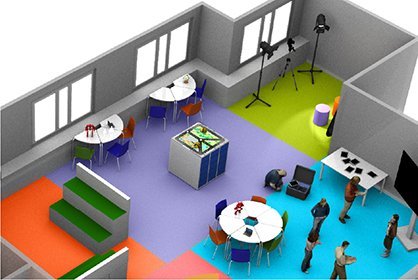 >
>
The Essentials of Future Classroom Lab: Discover the new learning zones and learn how to prepare your school for the future!
According to the "Learning Laboratories” initiative, developed by General Directorate of Education, in partnership with European Schoolnet (EUN), the classroom of the future foresees the creation of six distinct learning zones, which must be equipped with the proper technology to fulfill the purposes for which they were designed. The following is a brief summary of each of these new areas of the Future Classroom Lab, supplemented with suggestions for suitable hardware and software:
1. INTERACT Zone: Here the primary goal is to take advantage of technology to improve interaction between students.
Useful equipment / tools:
• Educational game software
2. CREATE Zone: the Future Classroom Lab places the student at the center of the learning process, and it is up to him to plan and produce his own work. The student must have several multimedia tools at his disposal, making use of them to create his content in support of video, audio, slides, editing programs etc.
Useful equipment / tools:
• High definition video camera
• Digital camera (pocket)
• Video editing software
• Audio recording equipment (for example microphones)
• Mix table
• Chroma blind
• Lighting
• Podcast software
• Animation software
• Streaming software
3. PRESENT Zone: one of the basic principles of the Future Classroom Lab is to learn how to communicate and share knowledge. This area should be an informal space dedicated to the presentation of diverse contents.
Useful equipment / tools:
• Reconfigurable furniture
4. INVESTIGATE Zone: the future is made up of active investigators. In this area, critical thinking and research in its multiple forms are privileged: reading, observation, online research, conducting scientific experiments, etc. It is the ideal place to question, test and evaluate.
Useful equipment / tools:
• Robots
• Sensors
• Data collection systems
• Graphical calculators
• Microscopes
• Online labs
• 3D models, etc.
• Printer (normal / 3D)
5. DEVELOP Zone: this will be an area of individual and informal learning, which enhances concentration, creativity and self-reflection. Here, each student follows their own pace to learn and build their own study supports
Useful equipment / tools:
• Informal furniture/study corners;
• Notebooks/tablets and related storage and charging carts
• Audio devices and earphones;
• Books and e-books;
• Educational games
6. COLLABORATION Zone: Collaboration and team work are fundamental in the Future Classroom Lab. It is a space dedicated to exchanging ideas, researching, sharing, creating and presenting contents.
Useful equipment / tools:
• Brainstorming/Wall Board
The digital age is here to stay. The investment of education in technology has been growing not only because it represents a need for now, with the global pandemic, but also for the future. If your educational institution does not yet have a classroom of the future, get in touch with us and take the next step. The innovation that you accept to invest today will represent your progress tomorrow.






